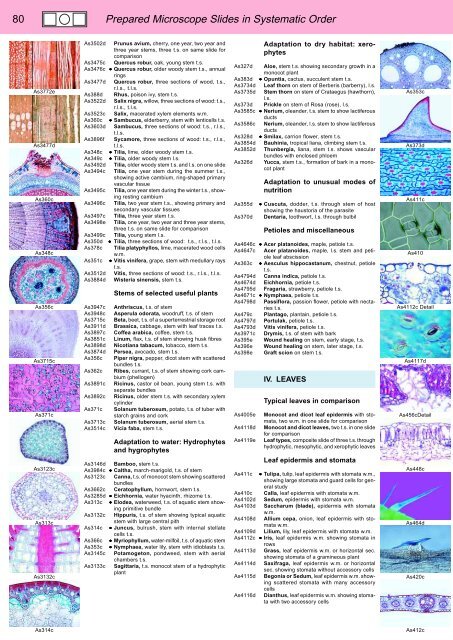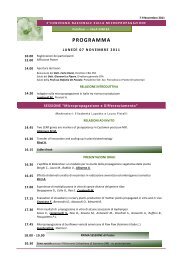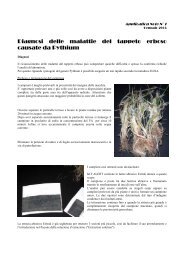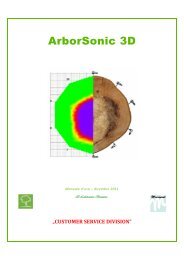BIOLOGY - microscopia.info
BIOLOGY - microscopia.info
BIOLOGY - microscopia.info
Create successful ePaper yourself
Turn your PDF publications into a flip-book with our unique Google optimized e-Paper software.
80<br />
Prepared Microscope Slides in Systematic Order<br />
As3772e<br />
As3477d<br />
As360c<br />
As348c<br />
As356c<br />
As3715c<br />
As371c<br />
As3123c<br />
As313c<br />
As3132c<br />
As3502d<br />
As3475c<br />
As3476c<br />
As3477d<br />
As388d<br />
As3522d<br />
As3523c<br />
As360c<br />
As3603d<br />
As3896f<br />
As348c<br />
As349c<br />
As3492d<br />
As3494c<br />
As3495c<br />
As3496c<br />
As3497c<br />
As3498e<br />
As3499c<br />
As350d<br />
As378c<br />
As351c<br />
As3512d<br />
As3884d<br />
As3947c<br />
As3948c<br />
As3715c<br />
As3911d<br />
As3897c<br />
As3851c<br />
As3898d<br />
As3874d<br />
As356c<br />
As362c<br />
As3891c<br />
As3892c<br />
As371c<br />
As3713c<br />
As3514c<br />
Prunus avium, cherry, one year, two year and<br />
three year stems, three t.s. on same slide for<br />
comparison<br />
Quercus robur, oak, young stem t.s.<br />
• Quercus robur, older woody stem t.s., annual<br />
rings<br />
Quercus robur, three sections of wood, t.s.,<br />
r.l.s., t.l.s.<br />
Rhus, poison ivy, stem t.s.<br />
Salix nigra, willow, three sections of wood: t.s.,<br />
r.l.s., t.l.s.<br />
Salix, macerated xylem elements w.m.<br />
• Sambucus, elderberry, stem with lenticells t.s.<br />
Sambucus, three sections of wood: t.s., r.l.s.,<br />
t.l.s.<br />
Sycamore, three sections of wood: t.s., r.l.s.,<br />
t.l.s.<br />
• Tilia, lime, older woody stem t.s.<br />
• Tilia, older woody stem l.s.<br />
Tilia, older woody stem t.s. and l.s. on one slide<br />
Tilia, one year stem during the summer t.s.,<br />
showing active cambium, ring-shaped primary<br />
vascular tissue<br />
Tilia, one year stem during the winter t.s., showing<br />
resting cambium<br />
Tilia, two year stem t.s., showing primary and<br />
secondary vascular tissues<br />
Tilia, three year stem t.s.<br />
Tilia, one year, two year and three year stems,<br />
three t.s. on same slide for comparison<br />
Tilia, young stem l.s.<br />
• Tilia, three sections of wood: t.s., r.l.s., t.l.s.<br />
Tilia platyphyllos, lime, macerated wood cells<br />
w.m.<br />
• Vitis vinifera, grape, stem with medullary rays<br />
t.s.<br />
Vitis, three sections of wood: t.s., r.l.s., t.l.s.<br />
Wisteria sinensis, stem t.s.<br />
Stems of selected useful plants<br />
Anthriscus, t.s. of stem<br />
Asperula odorata, woodruff, t.s. of stem<br />
Beta, beet, t.s. of a superterrestrial storage root<br />
Brassica, cabbage, stem with leaf traces t.s.<br />
Coffea arabica, coffee, stem t.s.<br />
Linum, flax, t.s. of stem showing husk fibres<br />
Nicotiana tabacum, tobacco, stem t.s.<br />
Persea, avocado, stem t.s.<br />
Piper nigra, pepper, dicot stem with scattered<br />
bundles t.s.<br />
Ribes, currant, t.s. of stem showing cork cambium<br />
(phellogen)<br />
Ricinus, castor oil bean, young stem t.s. with<br />
separate bundles<br />
Ricinus, older stem t.s. with secondary xylem<br />
cylinder<br />
Solanum tuberosum, potato, t.s. of tuber with<br />
starch grains and cork<br />
Solanum tuberosum, aerial stem t.s.<br />
Vicia faba, stem t.s.<br />
Adaptation to water: Hydrophytes<br />
and hygrophytes<br />
As3146d Bamboo, stem t.s.<br />
As3984c • Caltha, march-marigold, t.s. of stem<br />
As3123c Canna, t.s. of monocot stem showing scattered<br />
bundles<br />
As3662c Ceratophyllum, hornwort, stem t.s.<br />
As3285d • Eichhornia, water hyacinth, rhizome t.s.<br />
As313c • Elodea, waterweed, t.s. of aquatic stem showing<br />
primitive bundle<br />
As3132c Hippuris, t.s. of stem showing typical aquatic<br />
stem with large central pith<br />
As314c • Juncus, bulrush, stem with internal stellate<br />
cells t.s.<br />
As366c • Myriophyllum, water-milfoil, t.s. of aquatic stem<br />
As353c • Nymphaea, water lily, stem with idioblasts t.s.<br />
As3145c Potamogeton, pondweed, stem with aerial<br />
chambers t.s.<br />
As3133c Sagittaria, t.s. monocot stem of a hydrophytic<br />
plant<br />
As327d<br />
As383d<br />
As3734d<br />
As3735d<br />
As373d<br />
As3585c<br />
As3586c<br />
As328d<br />
As3854d<br />
As3852d<br />
As326d<br />
As355d<br />
As370d<br />
As4646c<br />
As4647c<br />
As363c<br />
As4794d<br />
As4674d<br />
As4795d<br />
As4671c<br />
As4798d<br />
As479c<br />
As4797d<br />
As4793d<br />
As3971c<br />
As395e<br />
As396e<br />
As398e<br />
As4005e<br />
As4118d<br />
As4119e<br />
As411c<br />
As410c<br />
As4102d<br />
As4103d<br />
As4108d<br />
As4109d<br />
As4112c<br />
As4113d<br />
As4114d<br />
As4115d<br />
As4116d<br />
Adaptation to dry habitat: xerophytes<br />
Aloe, stem t.s. showing secondary growth in a<br />
monocot plant<br />
• Opuntia, cactus, succulent stem t.s.<br />
Leaf thorn on stem of Berberis (barberry), l.s.<br />
Stem thorn on stem of Crataegus (hawthorn),<br />
l.s.<br />
Prickle on stem of Rosa (rose), l.s.<br />
• Nerium, oleander, t.s. stem to show lactiferous<br />
ducts<br />
Nerium, oleander, l.s. stem to show lactiferous<br />
ducts<br />
• Smilax, carrion flower, stem t.s.<br />
Bauhinia, tropical liana, climbing stem t.s.<br />
Thunbergia, liana, stem t.s. shows vascular<br />
bundles with enclosed phloem<br />
Yucca, stem t.s., formation of bark in a monocot<br />
plant<br />
Adaptation to unusual modes of<br />
nutrition<br />
• Cuscuta, dodder, t.s. through stem of host<br />
showing the haustoria of the parasite<br />
Dentaria, toothwort, l.s. through bulbil<br />
Petioles and miscellaneous<br />
• Acer platanoides, maple, petiole t.s.<br />
Acer platanoides, maple, l.s. stem and petiole<br />
leaf abscission<br />
• Aesculus hippocastanum, chestnut, petiole<br />
t.s.<br />
Canna indica, petiole t.s.<br />
Eichhornia, petiole t.s.<br />
Fragaria, strawberry, petiole t.s.<br />
• Nymphaea, petiole t.s.<br />
Passiflora, passion flower, petiole with nectaries<br />
t.s.<br />
Plantago, plantain, petiole t.s.<br />
Portulak, petiole t.s.<br />
Vitis vinifera, petiole t.s.<br />
Drymis, t.s. of stem with bark<br />
Wound healing on stem, early stage, t.s.<br />
Wound healing on stem, later stage, t.s.<br />
Graft scion on stem t.s.<br />
IV. LEAVES<br />
Typical leaves in comparison<br />
Monocot and dicot leaf epidermis with stomata,<br />
two w.m. in one slide for comparison<br />
Monocot and dicot leaves, two t.s. in one slide<br />
for comparison<br />
Leaf types, composite slide of three t.s. through<br />
hydrophytic, mesophytic, and xerophytic leaves<br />
Leaf epidermis and stomata<br />
• Tulipa, tulip, leaf epidermis with stomata w.m.,<br />
showing large stomata and guard cells for general<br />
study<br />
Calla, leaf epidermis with stomata w.m.<br />
Sedum, epidermis with stomata w.m.<br />
Saccharum (blade), epidermis with stomata<br />
w.m.<br />
Allium cepa, onion, leaf epidermis with stomata<br />
w.m.<br />
Lilium, lily, leaf epidermis with stomata w.m.<br />
• Iris, leaf epidermis w.m. showing stomata in<br />
rows<br />
Grass, leaf epidermis w.m. or horizontal sec.<br />
showing stomata of a gramineous plant<br />
Saxifraga, leaf epidermis w.m. or horizontal<br />
sec. showing stomata without accessory cells<br />
Begonia or Sedum, leaf epidermis w.m. showing<br />
scattered stomata with many accessory<br />
cells<br />
Dianthus, leaf epidermis w.m. showing stomata<br />
with two accessory cells<br />
As353c<br />
As373d<br />
As411c<br />
As410<br />
As4112c Detail<br />
As4117d<br />
As456cDetail<br />
As448c<br />
As464d<br />
As420c<br />
As314c<br />
As412c







